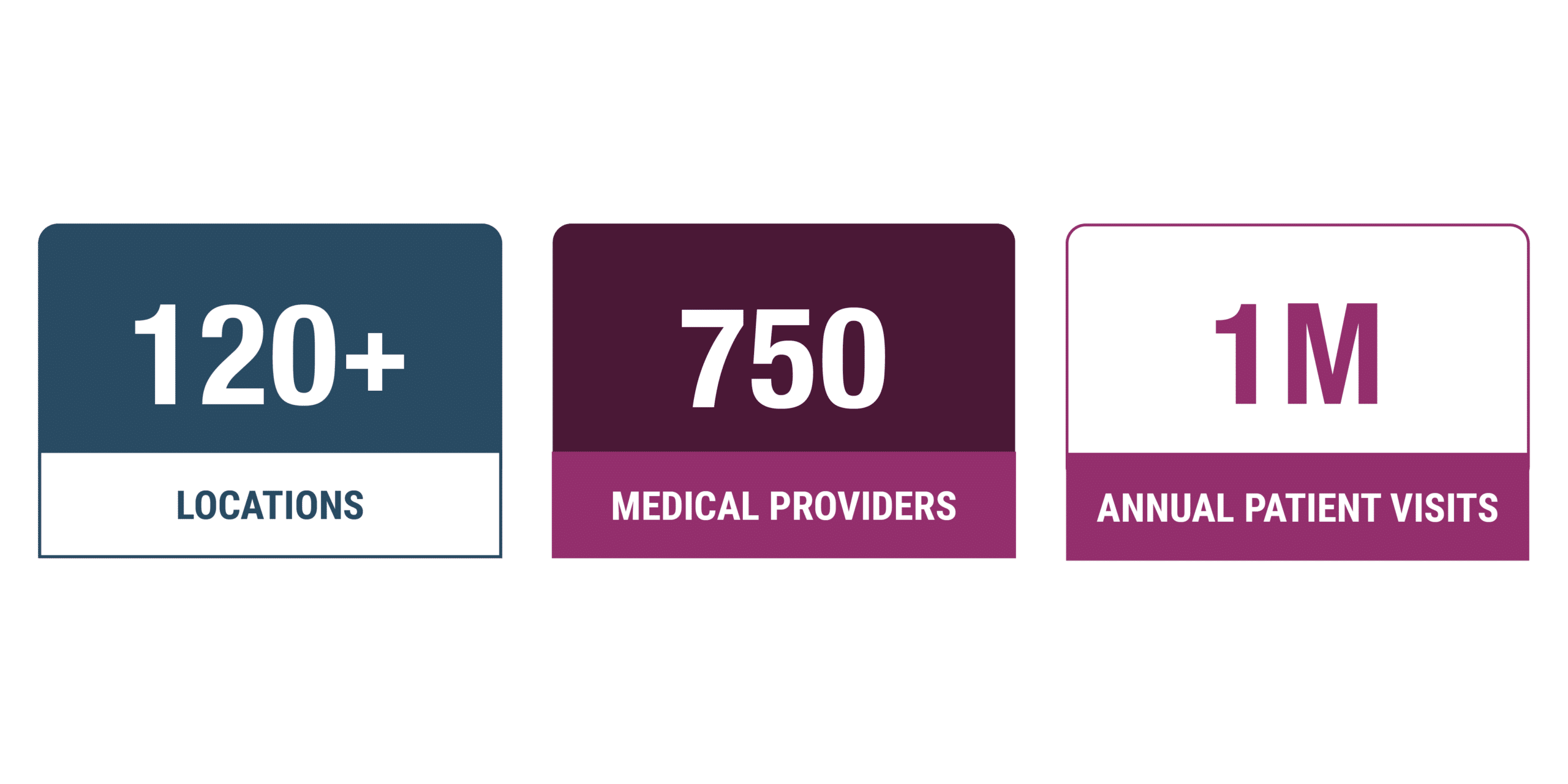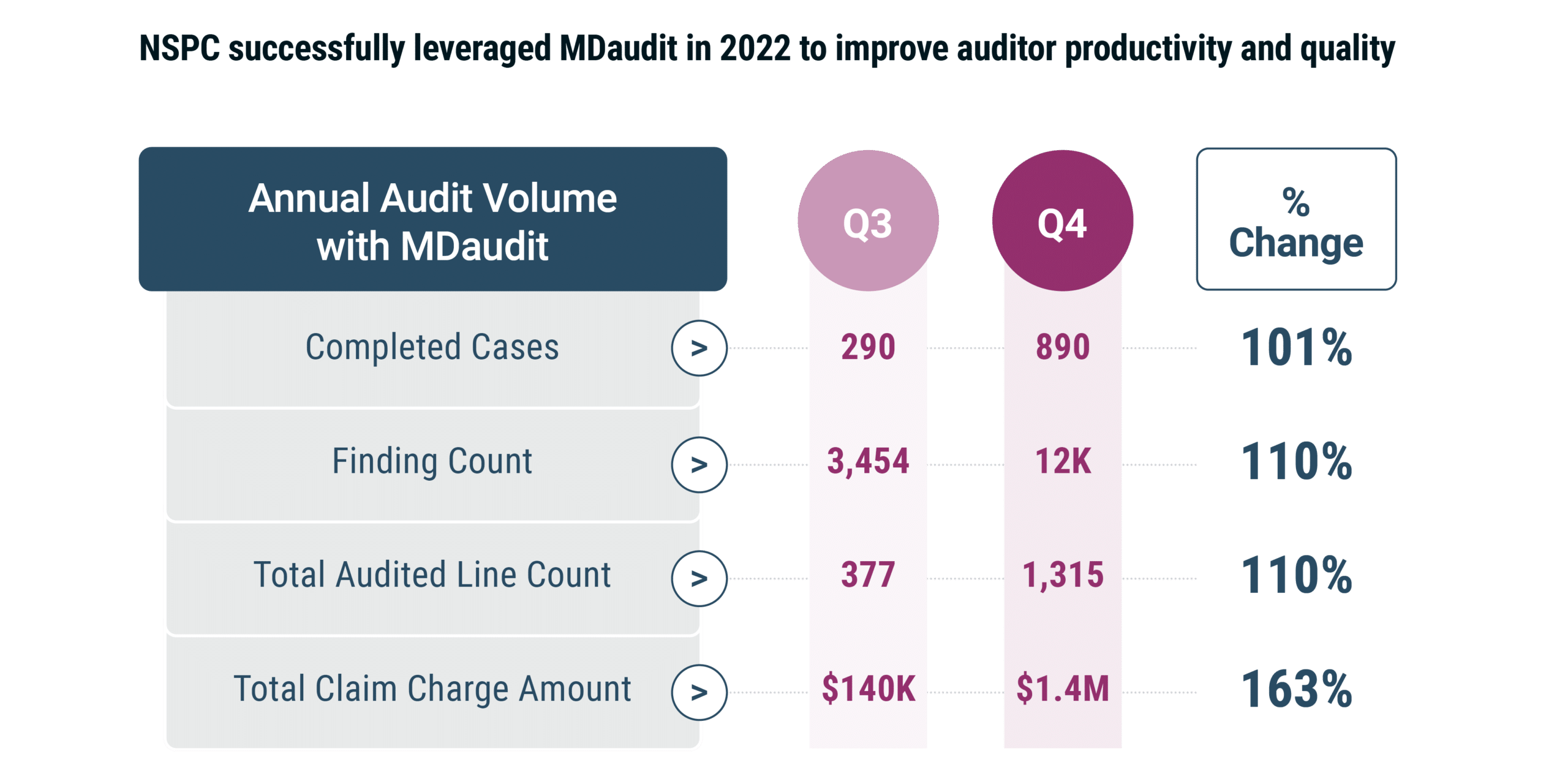THE CUSTOMER PROFILE
Based in Rockville, Maryland, National Spine and Pain Centers (NSPC), operate in more than 120 outpatient ambulatory surgical center locations nationwide. Founded more than 30 years ago, NSPC providers now see nearly one million patient visits each year.
This network of over 750 medical professionals specializing in treating acute and chronic pain has made it their mission to end needless human pain and suffering through world-class care. Physicians in the network are recognized for their extensive pain research and notable credentials – including many with double and triple board certifications.
THE CHALLENGE
The pain center needed on-demand data analytics to minimize compliance risk and denials.
Across coding, billing compliance, and revenue integrity departments, healthcare organizations strive to avoid risk and maximize revenue through more informed decisions and more effective actions. Auditors need tools to increase their efficiency and productivity by reducing time spent on labor-intensive preparation and reporting tasks.
When Kelly Martinelli joined NSPC as the director of compliance, her team relied on spreadsheets and reports generated by other departments for internal audits. And when it came to managing denials, there was no detailed information tracking because the health network’s billing resource lacked the capacity to gather or share that information.
The NSPC compliance department, leadership across the organization, and management in operations at each ambulatory surgical center location needed to understand and mitigate compliance risks and denials. To accomplish this, they required an integrated system to deliver on-demand data trending and analytics at their fingertips, with the ability to drill down to identify root causes and other relevant details. “You can improve anything if you can track and trend it,” Martinelli said. “Before MDaudit, we had no tracking and trending, even in compliance.”
Across coding, billing compliance, and revenue integrity departments, healthcare organizations strive to avoid risk and maximize revenue through more informed decisions and more effective actions. Auditors need tools to increase their efficiency and productivity by reducing time spent on labor-intensive preparation and reporting tasks.
You can improve anything if you can track and trend it.
Every little dollar adds up to a lot of dollars. It’s important that we get paid what we should so we can continue helping patients and ensuring our professionals can get paid for those services. MDaudit helps us do that.
THE SOLUTION
MDaudit offers functionality to increase revenues, minimize risk, and drive new efficiencies for stakeholders across the organization.
Martinelli was introduced to MDaudit in her previous role when it was recommended by a friend who served as the compliance officer at a neighboring academic hospital using the platform. Though her hospital did not purchase it at the time, Kelly stayed in touch with the team at MDaudit. “When I saw that we needed some method of tracking audits at NSPC, I knew MDaudit would be beneficial and so I reached out,” says Martinelli. “We started with Audit Workflows and expanded to Revenue Optimizer and other compliance modules.”
One favorite feature at NSPC is Procedure Utilization – a claim-based analytics tool available with Billing Risks that displays procedural billing patterns for easy analysis and trend detection. Leaders at NSPC use this data to protect and grow the business. With a clearer understanding of which procedures are being performed by which providers, NSPC can ensure proper medical malpractice coverage, recognize high producers in the organization, and identify opportunities to train providers on additional skills and procedures. It also allows the compliance team to vet new or emerging procedures. “Innovation is important to our providers and our patients,” says Martinelli. “It’s also important to ensure we get paid for these new procedures. We are tracking trends across payers, confirming our team is using correct CPT codes, auditing new providers when they start, and tracking their accuracy rate as well as holding all providers accountable with internal audits and education.”
Custom reports can be used to instantly uncover insights for one-off research queries or pinned for future reference within MDaudit. In the six months since NSPC went live on MDaudit, Martinelli and her team have made quick use of MDaudit’s pinboard feature. Pinboards are customizable, intuitive data visualization dashboards that offer overviews to system-wide trends with charts and graphs, and the ability to click directly into more detailed insights.
Martinelli has created boards for various members of the NSPC organization, including quarterly reports for the executive team, boards focused on specific regions or individual locations for operations managers, and specific boards for code audits based on immediate known risk areas. “With MDaudit, we are identifying issues and their cause so we can fix the process or educate providers,” describes Marinelli.
Based on denials data analytics in MDaudit, NSPC has increased training for staff on when an ABN is required, began following up with providers on timely filing limits, addressed credentialing issues, and created a process for automatically checking eligibility at registration. “And MDaudit shows our progress in the blink of an eye,” says Martinelli. “I was in a board meeting last week, and it was easy to show the decrease we’ve already made in denials with these new systems in place. Our leadership thinks MDaudit is the best thing since sliced bread. They’ve never seen software like this.”
Others beyond the NSPC executive team are seeing the benefits of MDaudit, too. “If you ask my staff, they are happy as could be with this system. They love it,” says Martinelli. “They don’t have to do extra work tracking it all in a spreadsheet and creating manual reports. It’s all done for them in MDaudit. It really cut down on their workload and made us so much more efficient.”
The increased efficiency has empowered the NSPC compliance team to focus on higher-value tasks, which is also decreasing organizational costs. Martinelli explains, “I was using an outside agency to help with internal audits. This year I’m not going to have to do that. I’m just going to be able to use our internal resources to get all of our audits done by the end of the year.”
With the ability to further prioritize resources and utilize the newly available access to data analytics, NSPC has just added its first Healthcare Business Analyst to leverage the insights of MDaudit further to identify trends and opportunities to drive revenue and reduce risk. “I’m excited to be working in the MDaudit system,” says Jacki Gallagher, the newly onboarded data analyst. “I can do a spot analysis, and it is all there, down to every detail. The system does it all for you and saves so much time. I have worked with many systems that take a few days to set up and receive a report, which MDaudit does immediately.”
The added efficiency of MDaudit protects the bottom line in other ways, too. With denials data automatically populating from electronic remits, the team can respond in a timelier manner or even request retroactive authorization, with easy access to the necessary information. “Being able to follow up in a timelier manner has already reduced our denials. And MDaudit helps us hold our providers accountable to ensure they are completing their documentation correctly and on time,” says Gallagher.
“Every little dollar adds up to a lot of dollars,” Gallagher explains. “It’s important that we get paid what we should so we can continue helping patients and ensuring our professionals can get paid for those services. MDaudit helps us do that.”
THE RESULTS
To download the full case study PDF, click here.








